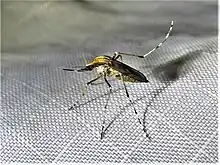| Aedes mitchellae | |
|---|---|
 | |
| Scientific classification | |
| Domain: | Eukaryota |
| Kingdom: | Animalia |
| Phylum: | Arthropoda |
| Class: | Insecta |
| Order: | Diptera |
| Family: | Culicidae |
| Genus: | Aedes |
| Species: | A. mitchellae |
| Binomial name | |
| Aedes mitchellae Dyar, 1905 | |
Aedes mitchellae mosquitoes were originally collected in southern Georgia and Florida in 1905 by entomologist Harrison Gray Dyar, Jr.[1] The species' range extends through the coastal plains from the southeastern United States, north to New York and west to New Mexico with the greatest abundance in the Atlantic and Gulf coastal plains.[2]
Bionomics
The adults, which resemble Aedes sollicitans,[1] are frequently captured in light traps.[2] Adult females have been characterized as "severe biters",[2] implying significance as a potential vector of arboviral diseases.
Larvae develop in fresh water in temporary rain-filled pools such as recently dug holes, puddles, temporary pools, and ditches, sometimes with emergent vegetation.[1][2] In the extreme south they are reportedly found throughout the year following rains.[2]
Medical importance
Ae. mitchellae is a suspected vector of Tensaw virus[3] and secondary vector of Eastern equine encephalitis.[4]
References
- 1 2 3 H. G. Dyar. 1905. A new mosquito. Journal of the New York Entomological Society 13: 74.
- 1 2 3 4 5 S. J. Carpenter and W. J. LaCasse. 1955. Mosquitoes of North America (North of Mexico). Berkeley, Los Angeles, London: University of California Press. Pp. 204-205; http://www.mosquitocatalog.org/files/pdfs/016800-0.pdf Archived 2016-03-14 at the Wayback Machine, accessed 1 Feb 2016.
- ↑ R. W. Chamberlain, W. D. Sudia, P. H. Coleman, J. G. Johnston, Jr., and T. H. Work. 1969. Arbovirus isolations from mosquitoes collected in Waycross, Georgia, 1963, during an outbreak of equine encephalitis. American Journal of Epidemiology 89(1):82-88; http://www.cabdirect.org/abstracts/19692704030.html;jsessionid=DAFE1FB0FFD8906B840F40B6F306B96E%5B%5D, accessed 1 Feb 2016.
- ↑ Zdenek Hubálek and Ivo Rudolf. 2011. Microbial Zoonoses and Sapronoses. Dordrecht, Heidelberg, London, New York: Springer. p. 135; e-ISBN 978-90-481-9657-9, DOI 10.1007/978-90-481-9657-9.